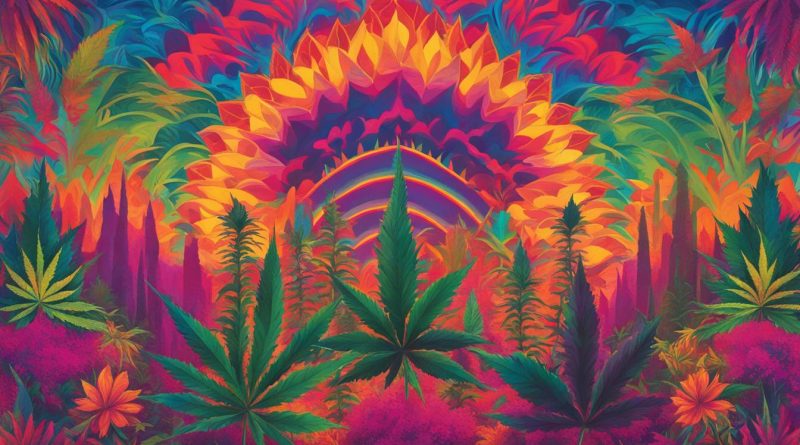Cannabis Representation in Popular Culture
Welcome to our article exploring the fascinating world of cannabis representation in popular culture. Over the years, cannabis has become an increasingly prominent feature in movies, music, and mainstream media, reflecting the ever-evolving societal trends and attitudes surrounding this plant. In this article, we will delve into the history, impact, and evolution of cannabis in pop culture, shedding light on its portrayal and influence in our modern entertainment landscape.
Key Takeaways:
- Cannabis has significantly influenced and been influenced by movies, music, and mainstream media.
- From the demonization of cannabis in films like “Reefer Madness” to its celebration in songs by artists like Bob Marley, the portrayal of cannabis has undergone significant shifts.
- Iconic movies like “Dazed and Confused” and “Friday” have contributed to the positive representation of cannabis in pop culture.
- The portrayal of cannabis in movies and TV shows often falls into either positive or negative stereotypes.
- As cannabis continues to be represented in popular culture, it plays a crucial role in shaping societal perceptions and promoting open dialogue.
The History of Cannabis in Pop Culture
In the realm of pop culture, cannabis has left an indelible mark, influencing and being influenced by various mediums such as movies and music. The portrayal of cannabis in pop culture has undergone a significant shift over the years, shaping public perception and the way it is depicted on the big screen and in music.
From the demonization of cannabis in films like “Reefer Madness” to its association with rebellion in movies like “Easy Rider,” the portrayal of cannabis has evolved and diversified. In the realm of music, artists like Bob Marley have normalized its use, spreading a message of unity and peace. Cannabis has come a long way in pop culture, traversing stereotypes and embracing a more nuanced representation.
“The portrayal of cannabis in pop culture has shaped societal attitudes and contributed to the normalization and acceptance of the plant.”
As we explore the history of cannabis in pop culture, we uncover a tapestry of representation that mirrors broader societal shifts. It is through these portrayals that pop culture has played a pivotal role in shaping the perception of cannabis, both positively and negatively. It is therefore essential to critically analyze these depictions, challenge stereotypes, and promote a more nuanced understanding of cannabis in society.
Cannabis in Movies:
Cannabis in movies has seen a dichotomy between positive and negative portrayals. Positive depictions can be found in films like “Up in Smoke,” where cannabis use is depicted as a source of humor and camaraderie. On the other hand, negative portrayals often feature exaggerated side effects and perpetuate stereotypes, as seen in stoner comedies.
Cannabis in Music:
In the world of music, cannabis has been celebrated across various genres, such as reggae and hip-hop. Artists like Bob Marley used their music to advocate for cannabis decriminalization and promote its positive attributes. The evolution of cannabis in music aligns with societal shifts, reflecting changing attitudes and acceptance.
The Impact on Society:
The representation of cannabis in pop culture has had a profound impact on societal perceptions and acceptance. As cannabis becomes more widely recognized and legalized, its portrayal in movies and music contributes to its normalization. By exploring the historical representation of cannabis in pop culture, we gain a better understanding of its influence on shaping perceptions and fostering open dialogue.
| Positive Portrayals | Negative Portrayals |
|---|---|
| “Up in Smoke” – Cannabis as a source of humor and camaraderie | Stoner comedies – Exaggerated side effects and perpetuation of stereotypes |
Through both positive and negative portrayals, cannabis has become an integral part of our pop culture landscape. As we continue to examine its representation in movies and music, we recognize its enduring influence on shaping societal attitudes and fostering conversations about its place in our world.
Classic Movies Featuring Cannabis (3 Examples)
Cannabis has played a significant role in shaping popular culture, and its representation in movies has been no exception. From comedies to dramas, there have been several classic films that have featured cannabis as a focal point or recurring theme. Let’s delve into three notable examples:
Dazed and Confused (1993)
In the film “Dazed and Confused,” directed by Richard Linklater, cannabis is portrayed as a common part of the characters’ lives in the 1970s. Set on the last day of high school, the movie follows a group of teenagers as they navigate the complexities of teenage life, including their experiences with cannabis. The film captures the essence of the era, highlighting the prevalent use of cannabis among the youth at the time.
Friday (1995)
“Friday,” a cult classic directed by F. Gary Gray, showcases cannabis consumption as a means of relaxation and bonding among friends. The comedy, starring Ice Cube and Chris Tucker, follows the adventures of two friends who spend a Friday getting into various misadventures in their neighborhood. Cannabis is depicted as a casual part of their routine, emphasizing its role in fostering camaraderie and providing an escape from the challenges of everyday life.
Half Baked (1998)
“Half Baked,” a stoner comedy directed by Tamra Davis, takes a light-hearted approach to cannabis use, breaking down stereotypes associated with cannabis users. The film revolves around a group of friends who embark on a mission to bail out their incarcerated comrade. Through humorous situations and exaggerated scenarios, “Half Baked” challenges societal perceptions and presents cannabis users in a more relatable and comedic light.
The Impact of Cannabis Representation in Pop Culture
The representation of cannabis in movies has had a profound impact on how it is perceived in society. By featuring cannabis in popular films, these movies have contributed to the normalization of the plant and helped shape public opinion. These classic movies, in particular, have played a significant role in portraying cannabis as a part of everyday life, fostering a more accepting and open-minded attitude towards its use.
Cannabis representation in pop culture continues to evolve, with filmmakers and artists pushing boundaries and challenging stereotypes. As societal attitudes towards cannabis change, the portrayal of the plant in movies will undoubtedly reflect these shifts, potentially leading to a more nuanced understanding and acceptance of cannabis in society.
The Portrayal of Cannabis in Movies: Effects and Stereotypes
The portrayal of cannabis in movies has had a significant impact on shaping public perceptions and reinforcing stereotypes associated with its use. Films tend to depict cannabis consumption in various ways, often highlighting its effects on characters and the consequences of its use. While some movies present cannabis in a positive light, others perpetuate negative stereotypes, emphasizing the dangers and risks associated with its consumption.

One common portrayal of cannabis in movies is its association with altered states of mind and a sense of rebellion against societal norms. This is often depicted through the use of comedic elements, where characters are shown engaging in unconventional behavior or experiencing exaggerated side effects. These portrayals can contribute to the perpetuation of stereotypes and misconceptions surrounding cannabis use.
On the other hand, certain films explore the potential risks and consequences of cannabis use. These movies often depict addiction and the negative impact that cannabis can have on individuals and their relationships. By showcasing the darker side of cannabis use, these films aim to present a more balanced perspective and raise awareness about the potential dangers associated with its consumption.
To challenge the stereotypes and misconceptions surrounding cannabis, it is essential to critically analyze the portrayals in movies. By promoting more nuanced and diverse representations of cannabis use, filmmakers can contribute to a better understanding of its effects and societal impact. This includes presenting responsible use, exploring different contexts in which cannabis is consumed, and portraying a range of characters who use cannabis for various reasons.
The Evolution of Cannabis in Music
Music has always been closely intertwined with cannabis, with the plant’s influence spanning various genres and eras. From its early association with jazz musicians in the 1920s to its prominent role in modern-day hip hop, cannabis has played a significant part in shaping the sound and culture of music. Let’s explore the evolution of cannabis in music and how it reflects the changing attitudes towards the plant.
Cannabis in Jazz: Breaking Boundaries
In the 1920s, cannabis became associated with jazz musicians who embraced the plant for its creative and relaxing effects. Renowned artists such as Louis Armstrong and Duke Ellington were known to enjoy cannabis, using it as a source of inspiration during their performances. The free-spirited nature of jazz and its rejection of societal norms made it a perfect match for cannabis, leading to its prominent presence in the genre.
Hip Hop and the Rise of Cannabis Culture
In the 1980s, cannabis began to permeate the world of hip hop, becoming an integral part of its culture and lyrical content. Artists like Snoop Dogg and Cypress Hill openly celebrated cannabis in their music, creating anthems that championed its use. Hip hop provided a platform for artists to voice their support for cannabis legalization and challenge the stigma associated with its consumption.
| Genre | Key Artists | Message |
|---|---|---|
| Jazz | Louis Armstrong, Duke Ellington | Cannabis as a source of inspiration |
| Hip Hop | Snoop Dogg, Cypress Hill | Cannabis celebration and advocacy |
| Reggae | Bob Marley, Peter Tosh | Cannabis as a symbol of unity and spirituality |
Reggae: The Rhythm of Cannabis
Reggae music, particularly through the legendary Bob Marley, has played a significant role in promoting cannabis as a symbol of unity, spirituality, and resistance. Marley’s music not only celebrated cannabis but also addressed social and political issues, with cannabis serving as a catalyst for change. Today, reggae continues to carry on this tradition, spreading a message of peace, love, and the benefits of cannabis.
The evolution of cannabis in music reflects the changing perceptions and attitudes towards the plant. From its early association with jazz, to its prominent role in hip hop, and its symbolic nature in reggae, cannabis has remained a constant presence in the world of music. Through the power of lyrics and melodies, artists continue to shape and redefine the portrayal of cannabis, contributing to the ongoing dialogue surrounding its use and legalization.

Good Joints, Bad Joints: Cannabis in Movies
In the realm of movies, cannabis portrayal often falls into two distinct categories: positive or negative. While music tends to celebrate cannabis use, movies often depict cannabis users as bumbling fools or dangerous outcasts. This dichotomy in media representation can be traced throughout the history of cannabis in films, with positive portrayals in movies like “Up in Smoke” and negative portrayals in stoner comedies focused on exaggerated side effects.
Positive representations of cannabis in movies, such as “Up in Smoke,” have helped to normalize the use of cannabis and challenge stereotypes. The film follows the misadventures of Cheech and Chong as they navigate their way through a hazy world of marijuana and comedy. By presenting cannabis use in a lighthearted and humorous manner, “Up in Smoke” contributed to changing public perceptions and paved the way for more positive portrayals in future films.
On the other hand, stoner comedies often exaggerate the side effects of cannabis use, perpetuating negative stereotypes. While these films can be entertaining and resonate with some audiences, they fail to provide a nuanced understanding of cannabis and its effects. It is crucial for filmmakers to move beyond these exaggerated portrayals and offer more realistic and diverse representations of cannabis in movies.
“Weed is not a drug. It’s a plant. It just grows like that. And if you just happen to set it on fire, there are some effects.” – Mitch Hedberg
As the stigma surrounding cannabis continues to evolve, it is essential for the film industry to embrace more balanced portrayals of cannabis and its users. By exploring both the positive and negative aspects of cannabis use, filmmakers can provide a more comprehensive and accurate representation of cannabis in society. This approach will not only challenge stereotypes but also contribute to a more informed and responsible public discourse surrounding cannabis.

| Film | Portrayal |
|---|---|
| “Up in Smoke” | Positive – Normalizes cannabis use, challenges stereotypes |
| “Reefer Madness” | Negative – Sensationalizes cannabis use, promotes fear |
| “Pineapple Express” | Mixed – Blends comedy with action, highlights consequences of cannabis use |
Table: Examples of Cannabis Portrayal in Movies
The Need for Nuanced Portrayals in Movies
In the realm of movies, the portrayal of cannabis has often fallen into stereotypical categories – either glorifying its use or depicting users as caricatures. While stoner comedies can be entertaining, these exaggerated portrayals can perpetuate stereotypes and hinder a more nuanced understanding of cannabis in society. It is essential for filmmakers to move beyond these extremes and offer a more balanced and realistic representation.
The Impact of Stereotypes
Stereotypes associated with cannabis use in movies can reinforce negative perceptions and create barriers to open dialogue. When characters are portrayed solely as “stoners” without any depth or complexity, it limits the scope of understanding surrounding cannabis use. By perpetuating these stereotypes, filmmakers miss an opportunity to explore the diverse experiences and motivations behind cannabis consumption.
“Movies have a powerful influence on shaping societal perceptions, and their portrayal of cannabis can either contribute to stigma or help break down misconceptions. It is crucial for filmmakers to challenge stereotypes and provide more nuanced portrayals that reflect the reality of cannabis use in people’s lives.”
Moving Toward Nuance
In order to promote a more nuanced understanding of cannabis, filmmakers should explore a broader range of characters and narratives. By depicting individuals who use cannabis responsibly and showcasing the positive aspects, movies can help dispel myths and challenge negative stereotypes. At the same time, it is important to acknowledge and examine the potential risks and consequences associated with cannabis use, presenting a balanced and realistic portrayal.
Through nuanced storytelling and multidimensional characters, movies have the power to shape public opinion and foster informed conversations about cannabis. By avoiding simplistic portrayals and embracing the complexity of real-life experiences, filmmakers can contribute to a more accurate and empathetic representation of cannabis in movies.
| Positive Portrayals | Negative Portrayals |
|---|---|
| – Depict responsible cannabis use | – Showcase exaggerated side effects |
| – Challenge stereotypes and stigma | – Reinforce negative perceptions |
| – Reflect diverse experiences | – Present one-dimensional characters |
TV’s Take on Cannabis: High Maintenance and More
When it comes to the representation of cannabis on TV, there has been a shift towards more nuanced portrayals in recent years. One show that stands out is “High Maintenance,” which offers a realistic depiction of characters who incorporate cannabis into their daily lives. The series explores the diverse perspectives and experiences of cannabis users, challenging stereotypes and providing a more authentic representation of the plant.
“High Maintenance” goes beyond the stoner comedy archetype and delves into the complexities of cannabis use. The show presents cannabis as an integral part of the characters’ lives, portraying different motivations for consumption, whether it be for relaxation, creativity, or medical purposes. The characters in “High Maintenance” are multi-dimensional, allowing viewers to relate to and understand their experiences with cannabis on a deeper level.
In addition to “High Maintenance,” other TV shows have also tackled the portrayal of cannabis with varying degrees of success. While some series have perpetuated stereotypes and one-dimensional characters, others have attempted to present a more balanced perspective. By exploring the diverse ways in which cannabis is used and the effects it can have on individuals, these shows contribute to a more nuanced understanding of the plant and its role in society.
The Impact of TV’s Representation
The inclusion of more realistic and diverse portrayals of cannabis on TV has the potential to shape public perception and challenge long-standing stereotypes. By showcasing the various reasons and ways in which people use cannabis, these shows promote a more open dialogue surrounding the plant. This can lead to increased awareness, understanding, and acceptance of cannabis in society.
It is important for TV shows to continue pushing boundaries and exploring the complexities of cannabis use. By offering more nuanced portrayals and avoiding one-dimensional stereotypes, television can play a crucial role in shaping the narrative surrounding cannabis and helping to combat stigma. As cannabis continues to become more accepted and legalized, television has the opportunity to pave the way for a more informed and inclusive conversation about the plant and its place in our culture.

The Impact of Cannabis Representation in Pop Culture
The portrayal of cannabis in pop culture has had a profound impact on shaping societal perceptions and attitudes towards the plant. As cannabis becomes more accepted and legalized, its representation in movies and music contributes to the normalization and acceptance of cannabis use. This article explores the evolving portrayal of cannabis in pop culture and its influence on shaping societal perceptions.
One of the key impacts of cannabis representation in pop culture is the promotion of open dialogue and discussions about the plant. By featuring cannabis in mainstream media, movies, and music, creators have sparked conversations about its effects, benefits, and potential risks. This has allowed for a more informed and nuanced understanding of cannabis, challenging stereotypes and misconceptions.
Furthermore, cannabis representation in pop culture has played a role in shaping public opinion and policy towards the plant. As movies and music showcase the positive aspects of cannabis use, such as its medicinal properties or its role in creative expression, society becomes more accepting of its consumption. This, in turn, has influenced the push for legalization and the decriminalization of cannabis in many parts of the world.
| Impact | Societal Perceptions |
|---|---|
| Normalization of Cannabis | Pop culture representation has contributed to the normalization of cannabis use, shifting public perceptions towards acceptance and understanding. |
| Education and Awareness | Pop culture representation has sparked conversations and increased awareness about the effects, benefits, and risks of cannabis use. |
In conclusion, the portrayal of cannabis in pop culture has had a significant impact on societal perceptions and attitudes towards the plant. Through movies and music, cannabis representation has normalized its use, sparked discussions, and influenced public opinion and policy. As cannabis continues to be represented in popular culture, it will play a crucial role in promoting a more informed and accepting society.
Conclusion
Cannabis in pop culture has come a long way, from being demonized to celebrated, with movies and music reflecting the changing perspective and acceptance of the plant. The evolving portrayal of cannabis in pop culture has had a significant impact on shaping societal perceptions and promoting a more nuanced understanding of its role in society.
As cannabis continues to be represented in movies and music, it remains a fixture in pop culture, capturing the attention and influencing the attitudes of audiences worldwide. The normalization and acceptance of cannabis in popular entertainment have played a crucial role in dispelling stereotypes and fostering open dialogue about its potential benefits and risks.
From classic movies like “Dazed and Confused” to iconic songs by artists like Bob Marley, cannabis has had a lasting impact on the creative expression and cultural fabric of our society. Its presence in pop culture serves as a reflection of the evolving societal trends and attitudes towards cannabis consumption. As we continue to explore the evolving portrayal and impact of cannabis in pop culture, we gain a greater understanding of its significance and its potential to shape the way we view and engage with this plant.
FAQ
How has cannabis been portrayed in pop culture?
Cannabis has been portrayed in various ways throughout pop culture, evolving from demonization to celebration. It has been depicted as a rebellious symbol, a means of relaxation, and even as a normalized part of everyday life.
Which movies have prominently featured cannabis?
Some examples of movies that have prominently featured cannabis include “Dazed and Confused,” “Friday,” and “Half Baked.”
How has cannabis been portrayed in music?
Cannabis has been associated with various music genres, from jazz in the 1920s to its prominent role in hip hop. Artists like Bob Marley have embraced cannabis and advocated for its decriminalization.
What are the common stereotypes associated with cannabis in movies?
Cannabis users in movies are often depicted as bumbling fools or dangerous outcasts. These stereotypes can perpetuate negative perceptions and hinder a more nuanced understanding of cannabis.
How has television represented cannabis differently from movies?
Television shows like “High Maintenance” have provided more realistic and diverse portrayals of characters who use cannabis in their daily lives, allowing for deeper exploration of the plant’s complexities.
What impact does cannabis representation in pop culture have on society?
The representation of cannabis in movies and music contributes to its normalization and acceptance in society, shaping perceptions and promoting open dialogue about the plant.













